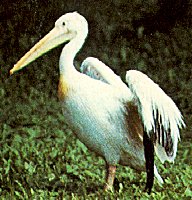 Synonyms:
None.
Synonyms:
None.Pelecanus onocrotalus (Linnaeus, 1758)
 Synonyms:
None.
Synonyms:
None.
Common names: Bulg: Rosov pelican; Engl: White pelican; Rom: Pelican comun; Russ: Pelikan rozoviy; Turk: Ak pelikan; Ukr: Pelikan rozhevy.
Order (Scientific): PELECANIFORMES.
Family (Scientific): PELECANIDAE.
Taxonomic descriptions: DU - a common, at some locations in Danube Delta a numerous species. In summer and autumn the number can be as high as 7,000 birds, in especially suitable places up to 1,500 or even 2,000 birds. NB - since 1990 migrants pass over Tendra bay in large flocks of more than 500, but despite such an increase a local depression is apparent.
 IUCN Status:
IUCN Status:
World level:
Black Sea Regional level:
Subregion level: VU (Ukraine sector)
Distribution:
Habitats type, Critical habitats, Limiting factors: Occurs primarily in the down-stream shallow riverine areas (Danube Delta) and shallow bays of the Black Sea. Habitat loss due to intensive breeding site transformation, disturbance, intensive eutrophication of the water-bodies.
Biology: A resident species in the Black Sea Region. Since 1995 the White Pelican has bred in small numbers in Tendra bay. Wintering grounds are in Bulgaria, Turkey, Iran, Iraq and Egypt. Fledglings occur from August. At the colonies it is sometimes associated with the Dalmatian Pelican and Cormorant. The nests are made of reeds and other hydrophilic plants and located either on a floating base near open water or on the shore. The clutch, which consists of 2, rarely 1 or 3 eggs, is incubated mostly by the female for 30-39 days. No second nesting is recorded. During migration and summer movements White Pelicans occur in the Azov-Black Sea area (lakes of the Kinburski peninsula, Tendrovski, Jagorlytski and Dzharalgachski bays) from April to the first ten days of October. Infrequent visitor to the NW Crimean coast. As ichtyophagi, White Pelicans populate areas with fish available in sufficient amounts. An adult requires 1 kg of fish daily. A family consumes about 700 kg during the 8 months' stay in the breeding area.
Population trends: The number of White Pelicans during migration and summer movements began to grow in the 1980s. The first breeding attempts were recorded in 1995 on Orlov Island. The numbers are relatively stable in the Danube delta. It was a numerous Crimean migrant in the XIX century, currently the species has significantly declined.
Threats: Habitat loss due to intensive breeding site transformation, disturbance, intensive eutrophication of the water-bodies.
Conservation measures taken: Protected in the "Dunaiskie Plavni" and "Chernomorski" reserves.
Conservation measures proposed: Prohibition of fishing in the water area of the "Dunaiskie Plavni" reserve, strengthening protection propaganda.
References:
Compiled by: T. Ardamatzkaia.